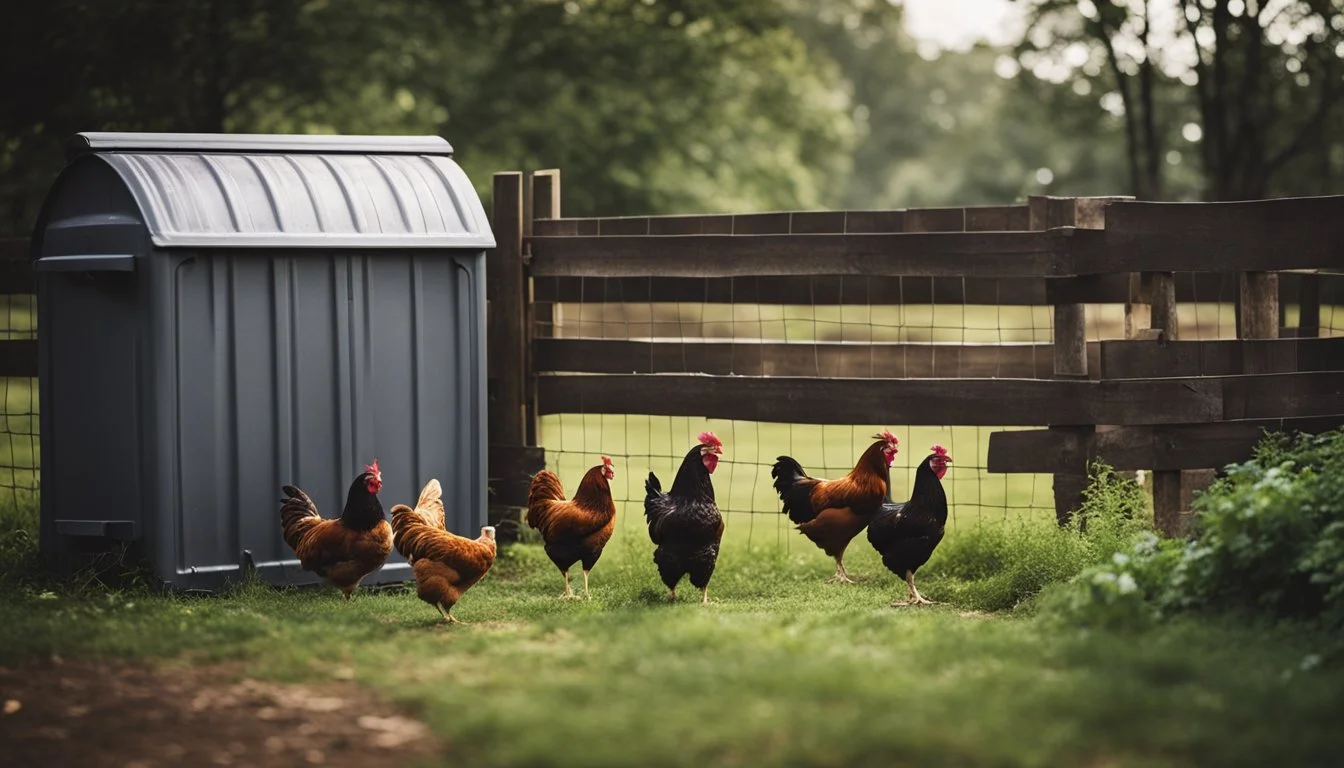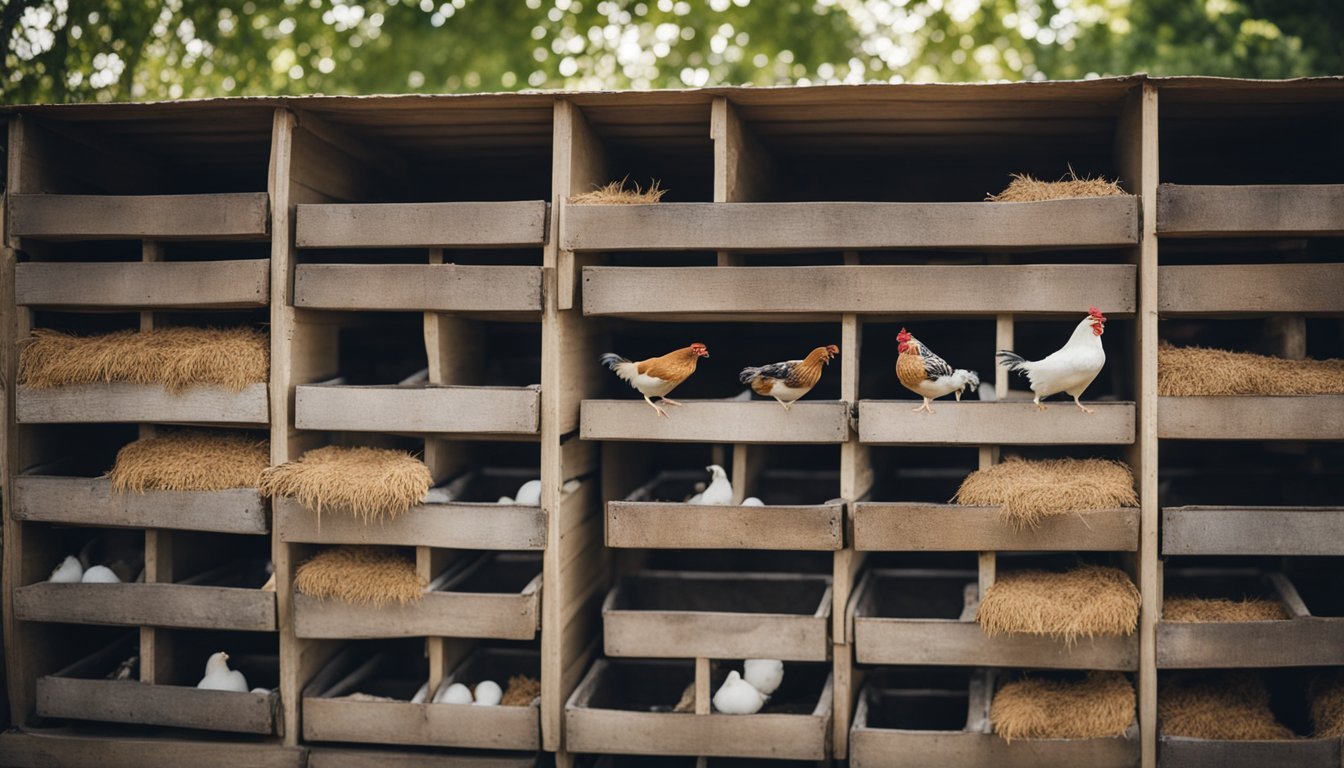8 Ways to Recycle and Reuse in Your Chicken Coop
Enhance Sustainability Today
In the quest to create a sustainable and cost-effective chicken coop, many poultry enthusiasts incorporate recycled and reused materials. This approach not only reduces waste but also provides an innovative way to manage resources efficiently. Understanding how to recycle and repurpose items for chicken coops can lead to significant savings and environmental benefits.
A chicken coop constructed with repurposed materials can still offer safety, comfort, and functionality for your flock. Whether it's using old wood, leftover metal, or discarded household items, the possibilities are both practical and creative. By considering these methods, one can maintain a balance between practicality and sustainability in poultry keeping.
1) Convert Old Buckets into Nest Boxes
Old buckets can be transformed into effective nest boxes for chickens. They provide a simple and economical solution for small or large flocks. The sturdy plastic of the buckets makes them durable and easy to clean, ensuring a hygienic environment for laying hens.
Start by acquiring clean 5-gallon buckets, ensuring they are free of harmful residues. Cut a hole large enough for a hen to enter on the side of each bucket. Secure the buckets side by side or stack them using bolts, screws, and nuts to create a stable structure.
Attach a lip to the front of each bucket to prevent bedding and eggs from falling out. This can be done using a piece of wood or cutting down a bucket lid to fit. Place the nesting boxes at a comfortable height for the chickens, ensuring they are easily accessible.
Add bedding material inside the buckets for comfort and to encourage egg laying. Straw, hay, or wood shavings are good options. Make sure to regularly check and replenish the bedding to maintain cleanliness.
By reusing old buckets in this way, chicken owners can create practical and cost-effective nesting solutions that promote a healthy coop environment.
2) Repurpose Wooden Pallets for Roosting Bars
Wooden pallets can be transformed into sturdy and practical roosting bars for a chicken coop. Disassembling a pallet requires some basic tools like a hammer and pry bar. The wooden slats from the pallet can be sanded down to remove any rough edges.
Once the pallet wood is prepared, it can be cut to the desired length for the roosting bars. The typical height for a roosting bar should be around 2 to 4 feet off the ground, depending on the breed size. Chickens need enough space to perch comfortably without overcrowding.
Arrange the bars parallel to each other, ensuring they are stable and secure. Using brackets or screws can help maintain the structure’s integrity. Pallet wood is generally sturdy enough to hold the weight of multiple chickens.
Reusing pallets in this way provides a cost-effective solution. Instead of purchasing new materials, you can recycle what you already have. Additionally, the natural wood material is preferable to plastics or metals for a roosting bar, offering a more pleasant roost for your birds. Repurposing also contributes to environmental sustainability.
3) Use Plastic Bottles as Feeders
Plastic bottles can be transformed into practical feeders for your chicken coop. Start by cutting the bottle in half and using the bottom section. This creates a simple feeder where chickens can peck at the feed. It’s a cost-effective solution that repurposes materials you likely already have.
To make a hanging feeder, cut small holes near the base of a plastic bottle. Fill the bottle with feed, then hang it upside down using string or wire. Gravity will help dispense the feed gradually, reducing waste and keeping the feed clean.
Another method involves creating a slit or multiple small openings along the side of a bottle. Fill the bottle with feed and lay it horizontally. Chickens can access the feed through these openings, preventing spillage and ensuring equal distribution among birds.
Maintaining these feeders is straightforward. Regularly clean them to avoid mold and bacteria buildup. Inspect for any sharp edges after cutting and smooth them to prevent injuries. This approach ensures your chickens have a reliable and hygienic feeding source.
4) Transform Tires into Dust Baths
Old tires can be an excellent resource for creating dust baths for chickens. Dust baths are essential as they help chickens stay clean and free from parasites.
To start, obtain a used tire from a local tire shop. Most tire places are willing to give them away for free.
Once you have the tire, place it in an area within the chicken coop or run. Make sure the location is sheltered from extreme weather.
Fill the tire with a mixture of dirt, sand, and wood ash. This combination provides the ideal dust bath material.
Adding Preen Queen, a common dust bath additive, can enhance the effectiveness against mites and lice.
For a fun twist, consider painting the tire. This can make the dust bath more visually appealing and an enjoyable project for kids.
Regularly check and replenish the dust bath mixture to keep it clean and effective. Chickens will naturally start using it to keep themselves groomed and healthy.
Repurposing tires in this way is not only environmentally friendly but also cost-effective.
5) Recycle Tin Cans for Treat Containers
Tin cans can be repurposed easily as treat containers for your chicken coop. By cleaning and decorating the cans, you provide a safe and accessible way to distribute treats.
Ensure the cans are thoroughly cleaned and any sharp edges are smoothed. This helps prevent any injuries to your chickens.
Once prepared, label the cans to identify different treats. For instance, one can might hold mealworms while another contains cracked corn.
You can also use a handle for easy transport. Punch two holes near the rim and attach a wire or rope handle.
Mounting options include hanging the cans on hooks or tree branches. This keeps them off the ground and ensures easier access for your chickens.
Decorating the cans not only makes them visually appealing but also helps blend them into your coop's aesthetic. Use non-toxic paint or materials if you choose to decorate.
Tin cans make convenient treat dispensers that are both practical and eco-friendly. This small recycling effort can enrich the daily routine of your chickens.
6) Create a Composter from Old Wooden Crates
Old wooden crates can be repurposed into a functional composter for the chicken coop. This provides a sustainable way to manage chicken manure and organic waste.
First, gather several wooden crates. Ensure they are sturdy and free from harmful chemicals or treatments.
Arrange the crates into a rectangular or square shape, with at least one opening for easy access. Use screws or nails to secure them together, ensuring stability.
Lastly, place the composter in a convenient spot within the coop area. This location should have good drainage and easy access for adding waste materials. A simple wooden crate composter can turn coop waste into rich compost for your garden.
7) Fashion Curtains from Recycled Fabrics
Creating curtains for the chicken coop from recycled fabrics can enhance its appearance and comfort. Old cotton clothing, bedsheets, and towels make excellent materials. Cotton is durable and easy to clean, making it a great choice for this purpose.
Finding a mix of different patterns and colors can add a touch of creativity. Make sure to choose fabrics that allow some light to filter through to keep the coop well-lit.
To fashion the curtains, cut the fabric into suitable sizes. Hem the edges to prevent fraying. Use a simple rod or wire to hang the curtains inside the coop. This provides shade and makes the environment more inviting for the chickens.
Recycling fabrics for this project not only helps reduce textile waste but also offers a cost-effective way to spruce up the chicken coop. This approach aligns with sustainable practices, benefiting both the environment and your feathered friends.
8) Utilize Broken Mirrors for Peck Toys
Broken mirrors can be repurposed as engaging peck toys for chickens. First, ensure that any sharp edges on the mirror pieces are smoothed or covered to prevent injury. Chickens are naturally curious and will be attracted to their reflections in the mirror.
Secure the broken mirror pieces in areas where chickens can safely peck at them. You can attach them to the sides of the coop or place them at ground level. The reflective surfaces stimulate their natural behaviors, offering mental stimulation and entertainment.
When installing, ensure that the mirrors are securely fastened and won't fall or be easily knocked over. This helps prevent any potential harm to the birds. Using adhesives or mounts designed for outdoor use can help achieve this.
In addition to providing entertainment, these peck toys can also reduce boredom and related issues such as feather pecking. By occupying their curiosity, broken mirror peck toys contribute to a healthier and happier coop environment. Always monitor your chickens to ensure they interact safely with the mirrors.
Benefits of Recycling and Reusing in Your Chicken Coop
Recycling and reusing materials in your chicken coop can significantly reduce environmental impact and save costs. It also provides a sustainable and economical approach to poultry keeping.
Environmental Impact
Using recycled materials for your chicken coop construction reduces waste and the need for new resources. Instead of purchasing new wood or metal, repurposing items like old pallets, scrap metal, or leftover building materials minimizes environmental degradation.
Chickens themselves can play a role in sustainability. Their waste can be composted and used as fertilizer for gardens, reducing reliance on chemical fertilizers. This integrated system supports local ecosystems and contributes to a healthier environment.
Moreover, recycling materials lessens greenhouse gas emissions tied to the production and transportation of new building supplies. It promotes a circular economy, encouraging more sustainable practices in everyday life.
Cost Savings
Constructing a chicken coop with recycled materials can lead to significant cost savings. New building supplies can be expensive, but items such as reclaimed wood, old windows, or unused fencing can often be sourced at little to no cost. These savings can be substantial, particularly for larger projects.
Additionally, reusing materials can reduce expenses related to waste disposal. Instead of paying to dispose of old materials, these resources are repurposed, further lowering overall costs.
Practical savings can also extend to operational efficiency. Chickens can help reduce kitchen waste by consuming food scraps, potentially lowering food disposal costs. This multi-faceted approach ensures that both initial construction and ongoing maintenance are economically efficient.
Materials That Can Be Recycled or Reused
Recycling and reusing materials in a chicken coop can be both cost-effective and environmentally friendly. There are various materials that can be repurposed to create a functional and durable space for your flock.
Wood and Lumber
Wood and lumber are highly versatile. Old pallets, leftover flooring, and discarded crates can be used to build the framework of the coop. Salvaged wood can become roost bars, nesting boxes, or even the coop's main structure.
Pallets are especially useful due to their durability. They can be deconstructed and the wood repurposed. It's essential to ensure the wood is untreated or safe for animals.
Crates and wooden boxes can be turned into nesting spots. Leftover or broken furniture pieces can also be repurposed to create different coop elements. For example, a discarded dresser can be transformed into an egg-laying station.
Metal and Wire
Metal and wire are crucial for ensuring the security and ventilation of a chicken coop. Items like galvanized roofing panels, old metal signs, and discarded fencing can protect against predators and weather.
Galvanized roofing panels can be sourced from scrap yards or old buildings. These panels are resistant to rust and can provide long-term protection for the coop’s roof.
Wire fencing is another significant component. Old fencing materials can be reused to create a secure perimeter. Hardware cloth is particularly effective for preventing predators from reaching the chickens. Ensure that metal materials are free from rust and sharp edges to avoid injuries.
Plastic and Rubber
Plastic and rubber materials can serve various practical purposes in a chicken coop. PVC pipes, for example, can be used to create feeders, waterers, or even frames for temporary structures.
Plastic barrels and containers can be converted into storage units for feed and other supplies. They are also effective for creating weatherproof hatches and doors. Rubber materials like old tires can provide dust bathing stations or act as barrier materials.
Reusing these materials not only saves money but also helps reduce waste. Ensure that any plastic or rubber items are thoroughly cleaned and sanitized before repurposing them in the coop to maintain hygiene and safety.
Safety and Hygiene Considerations
Maintaining a clean and structurally sound coop is essential for the health and safety of your chickens. By preventing contamination and ensuring the structural integrity, you can create a safer environment for your flock.
Preventing Contamination
Regular cleaning and disinfection are crucial to prevent contamination in a chicken coop. Clean food and water containers daily, removing any wet or caked feed and washing them with poultry-safe cleaners. Allow them to dry completely before refilling.
Remove loose debris and sweep the coop regularly. Use a scraper or putty knife to remove stubborn spots or dried-on waste. Follow this up with a thorough scrubbing using brushes and disinfectants, paying close attention to areas where waste tends to accumulate, such as nesting boxes and roosting bars.
Additionally, cover the floor with a clean, dry tarp and add bedding. When it's time to clean, dispose of the bedding and disinfect the tarp before reusing. This practice helps maintain a cleaner environment and reduces the risk of bacterial growth.
Ensuring Structural Integrity
Regular inspections are vital to ensure the structural integrity of the chicken coop. Check for any signs of wear and tear, such as broken boards, loose nails, or damaged hardware. Repair or replace any compromised components promptly to avoid accidents or potential predator access.
Make sure the coop is properly ventilated to prevent moisture buildup, which can lead to mold growth and respiratory issues. Adjust vents or openings to ensure adequate airflow without causing drafts.
Ensure that roosting bars and nesting boxes are sturdy and securely fastened. Check for pests like mites or rodents that can weaken the coop's structure and harm your chickens. Regular upkeep and maintenance will help provide a safe and secure living space for your flock.







